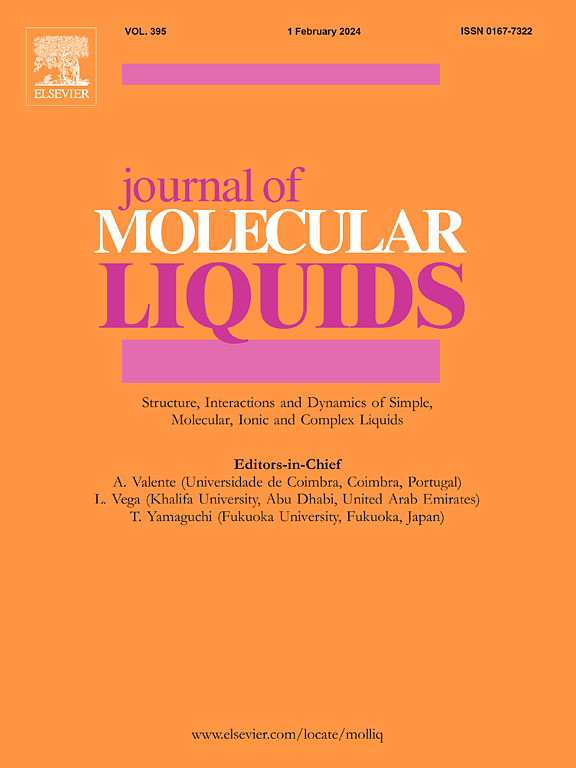掺杂mo的NiFe2O4纳米颗粒对有机污染物的同时吸附:实验和计算研究
IF 5.3
2区 化学
Q2 CHEMISTRY, PHYSICAL
引用次数: 0
摘要
用吸附法修复污水需要重复的吸附剂分离费用。虽然超顺磁吸附剂可以将这些成本降低到可以忽略不计的水平,但它们对大多数有机污染物的吸附性能很差。适当的掺杂可以大大改变这些材料的吸附性能。在这里,我们合成了三种mo掺杂的NiFe2O4纳米粒子,分别掺杂了1、2和4个原子百分比的mo,并研究了甲基橙(MG)和环丙沙星(CIP)在水溶液中的共吸附。钼(Mo)的电负性高于镍或铁。XPS分析和DFT计算表明,掺杂影响了掺杂材料中的电子分布,导致不同的吸附剂产生三种类型的吸附位点。后者对于从水溶液中有效地同时共吸附多种有机污染物是必不可少的。在接近中性的pH条件下,1% mo掺杂的NiFe2O4 (1MNIF)纳米颗粒表现出最佳的CIP和MG共吸附去除效果。mnif对CIP的吸附量为22.70 mg·g−1,对mg的吸附量为18.95 mg·g−1。这些值比使用纯NiFe2O4纳米颗粒共吸附CIP和MG时所观察到的值高约5倍。平衡等温吸附数据最符合扩展Freundlich等温模型,符合吸附剂上异相位点的共吸附。本文章由计算机程序翻译,如有差异,请以英文原文为准。
Simultaneous adsorption of organic pollutants on Mo-doped NiFe2O4 nanoparticles: Experimental and computational studies
Polluted water remediation by adsorption entails repeated adsorbent separation costs. While superparamagnetic adsorbents can reduce these costs to negligible levels, their adsorption properties towards most organic pollutants are poor. Appropriate doping of such materials can alter their adsorption properties drastically. Here, we synthesized three Mo-doped NiFe2O4 nanoparticles with 1, 2, and 4 atomic percent Mo-doping and examined the co-adsorption of methyl orange (MG) and ciprofloxacin (CIP) from an aqueous solution on each adsorbent sample. Molybdenum (Mo) has higher electronegativity than Ni or Fe. XPS analysis and DFT calculations show doping affects electron distribution in the doped material causing three types of adsorbent sites specific to different adsorbates. Latter is essential for efficient concurrent co-adsorption of multiple organic pollutants from an aqueous solution. The one-percent Mo-doped NiFe2O4 (1MNIF) nanoparticles demonstrated optimum CIP and MG co-adsorption removal from their aqueous solution under near-neutral pH conditions. The adsorption capacities of 1MNIF were 22.70 mg·g−1 for CIP and 18.95 mg·g−1 for MG. These values are approximately 5 times higher than those observed for the co-adsorption of CIP and MG using the pure NiFe2O4 nanoparticles. The equilibrium isothermal adsorption data best fitted the extended Freundlich isotherm model, keeping with co-adsorption on heterogeneous sites on the adsorbent.
求助全文
通过发布文献求助,成功后即可免费获取论文全文。
去求助
来源期刊

Journal of Molecular Liquids
化学-物理:原子、分子和化学物理
CiteScore
10.30
自引率
16.70%
发文量
2597
审稿时长
78 days
期刊介绍:
The journal includes papers in the following areas:
– Simple organic liquids and mixtures
– Ionic liquids
– Surfactant solutions (including micelles and vesicles) and liquid interfaces
– Colloidal solutions and nanoparticles
– Thermotropic and lyotropic liquid crystals
– Ferrofluids
– Water, aqueous solutions and other hydrogen-bonded liquids
– Lubricants, polymer solutions and melts
– Molten metals and salts
– Phase transitions and critical phenomena in liquids and confined fluids
– Self assembly in complex liquids.– Biomolecules in solution
The emphasis is on the molecular (or microscopic) understanding of particular liquids or liquid systems, especially concerning structure, dynamics and intermolecular forces. The experimental techniques used may include:
– Conventional spectroscopy (mid-IR and far-IR, Raman, NMR, etc.)
– Non-linear optics and time resolved spectroscopy (psec, fsec, asec, ISRS, etc.)
– Light scattering (Rayleigh, Brillouin, PCS, etc.)
– Dielectric relaxation
– X-ray and neutron scattering and diffraction.
Experimental studies, computer simulations (MD or MC) and analytical theory will be considered for publication; papers just reporting experimental results that do not contribute to the understanding of the fundamentals of molecular and ionic liquids will not be accepted. Only papers of a non-routine nature and advancing the field will be considered for publication.
 求助内容:
求助内容: 应助结果提醒方式:
应助结果提醒方式:


